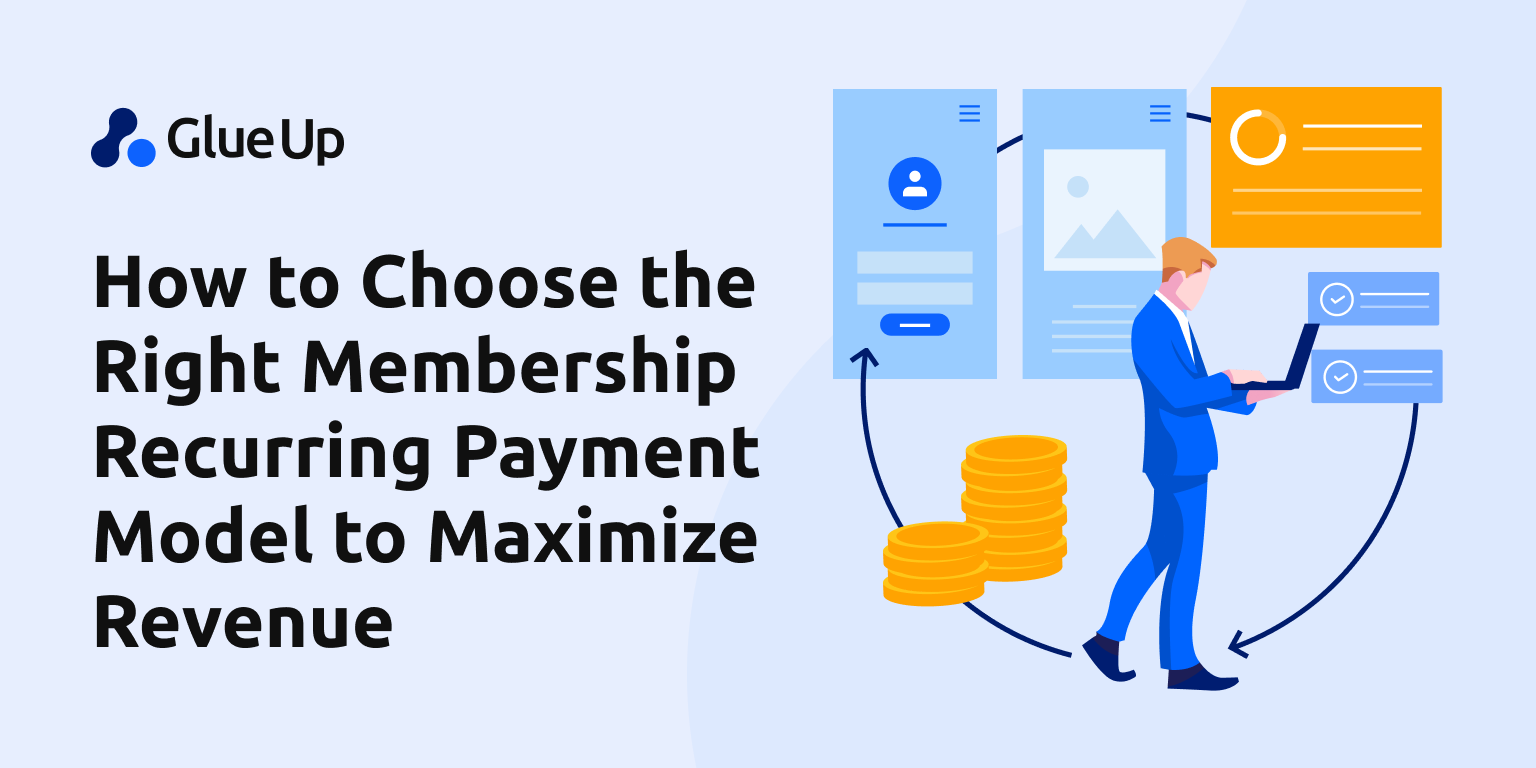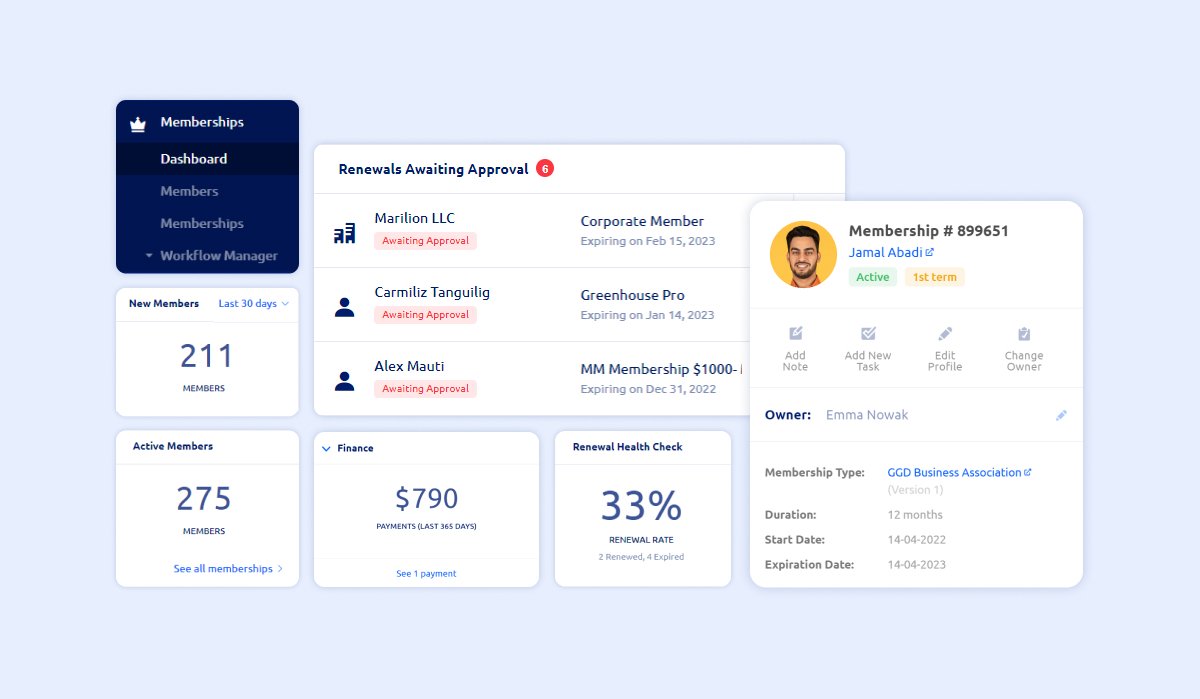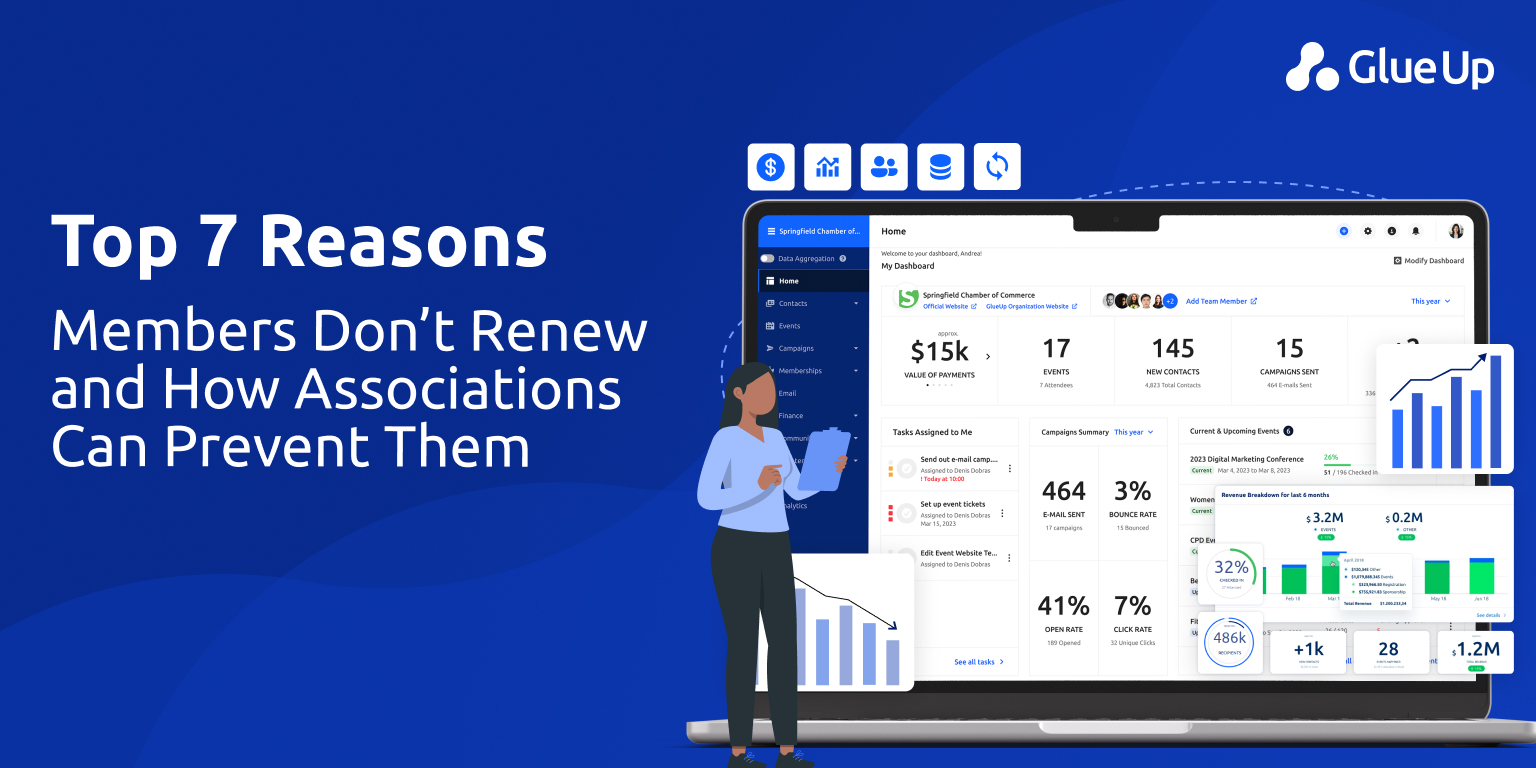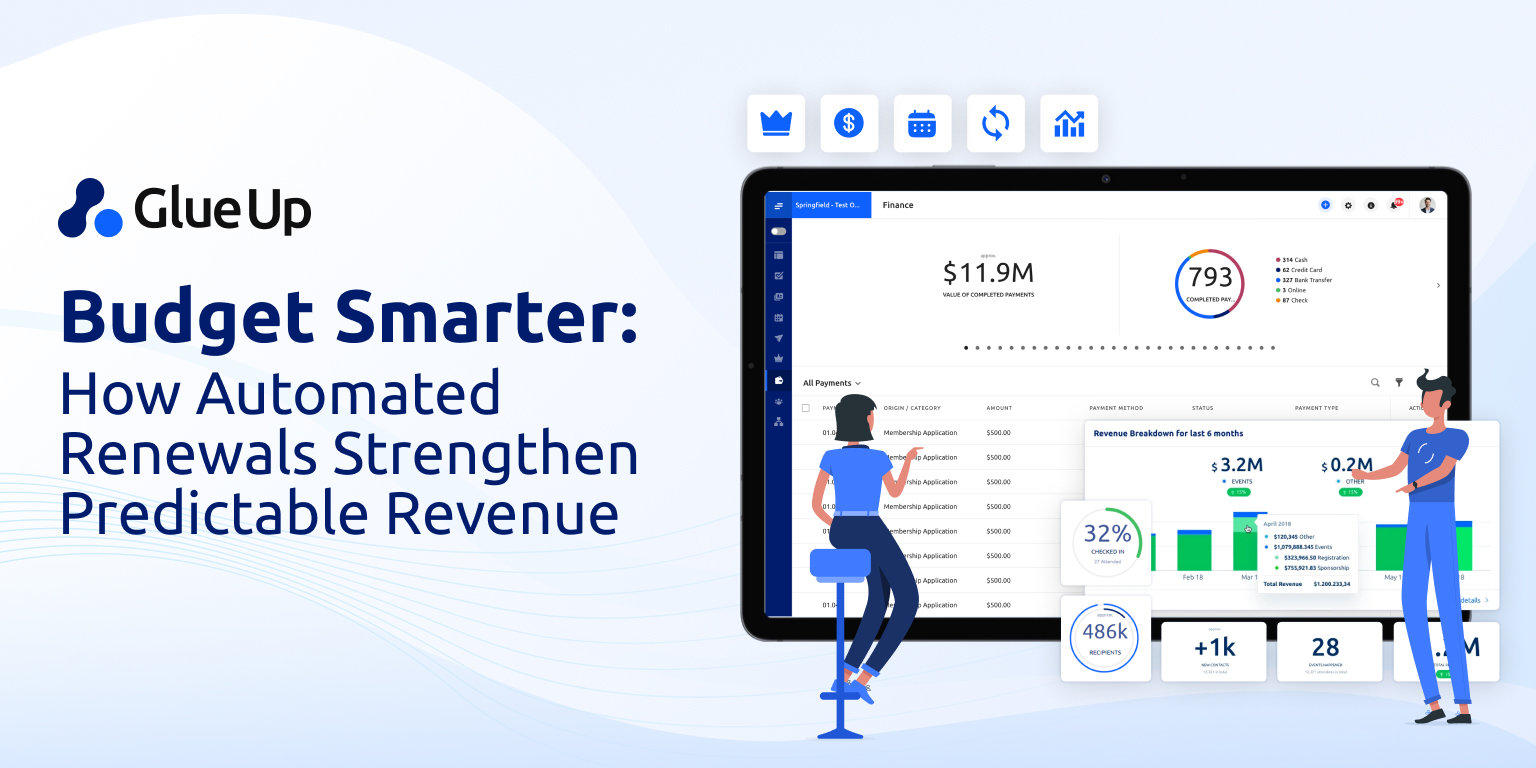
When choosing a Membership Recurring Payment Model, it's important to recognize that almost every recurring payment model plays a key role in generating revenue for businesses. The decision is not that simple; it depends on factors such as your membership base, the nature of your services or products, your pricing structure, and the benefits offered.
However, this complex decision-making process requires careful consideration. In this blog, we'll explore these diverse models to help you select the most suitable model for your business, addressing your unique circumstances and objectives.
Key Takeaways
- When choosing a recurring payment model, recognize your membership base's diverse needs and preferences. Tailor your approach to align with your members' demographic, geographic, and service-related variations.
- Thoroughly evaluate your organization's services and benefits before selecting a membership model. Consider whether a tiered approach with differentiated benefits, a subscription model with fixed services, or a usage-based model aligns best with the value you offer.
- Align your chosen membership model with your organization's goals and long-term vision. Whether scalability, revenue predictability, or maximum member value is your priority, ensure your membership model strategically supports your overall organizational objectives.
- Be open to testing different models with pilot groups and gathering feedback. Flexibility and adaptability are crucial, allowing you to refine your approach based on member responses and changing organizational needs over time.
- Glue Up provides a comprehensive platform that streamlines recurring payment processes for membership models. From automatic billing to online renewal and automated reminders, Glue Up enhances efficiency, ensuring a seamless experience for both administrators and members.
What is Membership Recurring Payment
Before investigating the different recurring payment models, let's first understand what a recurring payment model explains. This payment model enables you to charge your members or customers repeatedly for the services, benefits, or products you provide to them.

For members, it offers convenience, avoiding the need to acquire a new membership each time; they continue paying to maintain their membership. Likewise, it serves as a steady stream of incoming revenue for businesses and associations, eliminating the constant need to acquire new clients.
The recurring model can be monthly, quarterly, or yearly billing, depending on the members’ preferences. However, this model's basic principle is its ability to maintain a consistent and reliable cash flow for the service provider.
Understanding the Importance of a Recurring Payment Model for Member Organizations
A recurring payment model is crucial for member organizations. It offers several key benefits that improve operational efficiency and member satisfaction.
Here are the main reasons why adopting this model is important:
- Reliable Revenue Stream: Recurring payments provide a steady, predictable cash flow, allowing organizations to plan for long-term financial stability and budgeting.
- Reduced Administrative Burden: Automating payments eliminates the need for manual invoicing and follow-up, freeing up time for staff to focus on growth strategies and member engagement.
- Increased Member Retention: When payments are automatically processed, members are less likely to let their memberships lapse, improving overall retention rates.
- Convenience for Members: Automatic renewals simplify the process for members, offering a seamless experience without the need to manually renew their membership.
- Minimized Late Payments: With recurring payments, the risk of late or missed payments decreases, ensuring that memberships remain active and that revenue isn’t interrupted.
What Are the Different Types of Membership Recurring Payment Models?
Membership organizations, including associations and chambers, depend on recurring membership payments to maintain operations and support members. The selection of an appropriate payment model has considerable influence on member engagement, revenue stability, and administrative efficiency.

Below, we explore several recurring payment models along with their potential advantages for associations and chambers:
Tiered Membership
Tiered membership offers a range of plans: Silver, Gold, and Diamond. The Silver Plan may provide basic services, while the Gold Plan may add more benefits. The Diamond Plan is the most premium, offering an extensive set of exclusive services.
Members can choose a plan based on their preferences and desired level of privileges. Let's analyze this membership model in detail and see what it offers.
Structure
The basic structure of tiered membership is designed to provide options that cater to individual members’ diverse needs and preferences. Recognizing that members vary in their requirements, preferences, and business sizes, tiered membership structures introduce different levels or tiers to address these variations.
For example, the needs of a small business with fewer employees may differ significantly from those of a larger enterprise with hundreds of employees. A company with 10-20 employees would happily pay a few hundred dollars for a standard package, including one or two services such as audit or tax filing.
In contrast, a company with 500-1000 employees would be willing to invest thousands of dollars in a premium package that includes all the services, such as QuickBooks support, audit, consulting, and tax returns.
This variability in needs and preferences across members and businesses gives rise to the concept of tiered membership. By establishing different tiers, associations can effectively cater to the specific requirements of their diverse membership base, ensuring that each member can access services that align with their interests and objectives.
Benefits
The tiered membership model comes with various advantages. It caters to diverse member needs by allowing them to pay for the specific services they require. This budget-friendly approach is beneficial for businesses of every size, ensuring that each category can find a suitable plan.
Statistics suggest existing customers are 50% more likely to buy from you and are willing to pay 31% more for your services than new customers. Thus, if you offer tiered membership, your existing customers are likelier to buy and try out these different plans.
Moreover, the model maximizes revenue potential by enabling members to save costs on services they do not need. This saved amount can be strategically spent on other areas, such as marketing, logistics, stocks, or any aspect that offers an opportunity for additional revenue.
Additionally, it encourages upgraded paths, giving members the flexibility to move up to higher tiers whenever they see fit.
Considerations
Careful planning is essential if you plan to launch a tiered membership. Differentiating the value offered by each tier is essential to prevent confusion and potential resentment.
This ensures that members understand they are getting distinct value for their money. Clear differentiation helps avoid any perception that a higher tier offers only minor differences compared to a lower one, especially if the fees are considerably higher. This transparency is key to building trust and improving member experience.
In this way, members are satisfied with the unique benefits associated with their chosen tier. Also, Keeping the communication transparent and straightforward during the launch phase helps set realistic expectations, providing a positive member experience from the start.
Subscription-based
A subscription-based approach involves providing all members with a standardized set of services at the same fixed fee. This model does not consider the diverse preferences, specific needs, or variations in the size of businesses that individual subscribers may have. Let's learn more about this membership model and explore its details closely.
Structure
A subscription-based model suggests offering members a fixed set of services or benefits, distinct from the tiered membership approach. Similar to how platforms like Netflix or Spotify provide subscription services to customers, businesses adopting this model extend comparable membership facilities.
The structure involves charging a predetermined amount, for instance, $50 or $100 per month or year, and ensuring each member receives the same standardized services without differentiation.
Benefits
The subscription-based model has a range of advantages. One notable benefit is the predictable revenue stream, which provides businesses with a consistent and reliable income source. This predictability allows for better revenue forecasts and financial planning.
Moreover, this model promotes ongoing engagement with members. Businesses can maintain a continuous and lasting relationship with their subscribers by offering fixed services or benefits.
This ongoing engagement not only increases member loyalty but also opens opportunities for businesses to understand and respond to their members' evolving needs.
Another key advantage is transparency. A subscription-based model clearly defines the terms and services, ensuring members understand what they receive in exchange for their subscription. This transparency builds trust and contributes to a positive member experience.
Considerations
When choosing to adopt a subscription-based model, it's crucial to ensure that the price charged justifies the value of the services or benefits provided; otherwise, it could potentially harm your reputation.
To maintain a fair value exchange, the fee structure must be balanced—neither too high nor too low.
Additionally, you should avoid marketing your subscription offer to individuals who only require occasional services. Pitching the offer to the wrong audience may result in low conversion rates, lead to negative perceptions, and adversely impact your overall marketing strategy.
Usage-based
The next membership model is the usage-based model. As the name suggests, members pay an amount based on the quantity of services or benefits they use. It's a straightforward concept where you only pay for what you use—nothing extra. Let's dig into the details of this model to gain a better understanding of its offerings.
Structure
In this model, members are allowed to pay for the services they've used—a concept similar to shopping for groceries, where you pay for what you buy, providing members or customers with clarity about what they are paying for.
Yes, it's a recurring payment model, but the charges can vary from the last bill to the next bill, depending on the usage. Notably, services such as Amazon Web Services and Google Cloud also have adopted this same pay-for-usage model.
Benefits
This model offers numerous benefits, making it increasingly popular among businesses. According to the reports, 46% of SaaS businesses adopted a usage-based pricing model in 2022, and this index is projected to reach 61% by the end of 2023.
However, its notable advantages include encouraging active participation while discouraging freeloading, promoting efficient resource allocation, attracting new customers, providing valuable usage data, and aligning costs with perceived value.
Considerations
When adopting this model, it's essential to consider a few key aspects:
- Tracking and Billing Systems: Implementing a reliable tracking and billing system is crucial for accurate measurement and invoicing.
- Administration: Administering this model can be complex, requiring careful attention to detail and efficient management systems.
- Service Suitability: It's important to acknowledge that the usage-based model may not suit all types of service offerings. A thorough evaluation of the nature of the services is necessary.
In terms of the pricing, careful consideration is also required. Choose appropriate metrics, such as:
- Per Unit: Charging based on the quantity or units of service used.
- Per Time: Billing customers based on the time duration of service usage.
- Tiered Structures: Implementing different pricing structures to accommodate varying levels of service usage.
Moreover, customer education is a critical component for successfully implementing this model. Provide clear guidance and support to help customers understand how to manage usage and associated costs effectively.
Hybrid Model
The hybrid model, combining different membership structures like usage-based, tiered, or subscription, provides members with a variety of options. This flexibility allows businesses to tailor plans to individual needs, optimizing value and enhancing customer satisfaction. The hybrid model has so much to offer; let's go through its offerings:
Structure
The concept behind the structure of the hybrid model is to add various membership models to cater to the diverse needs of members effectively. For instance, introducing the hybrid membership model could be beneficial if you are operating an association or chamber of commerce and aspire to acquire a broad spectrum of members.
This model can incorporate tiered membership plans, offering different options at various prices, alongside a subscription model where everyone gets the same plan at the same price and a usage-based model where members pay for what they use.
In this way, the hybrid membership model allows you to address the needs of every customer in the market, providing a versatile and inclusive approach to membership offerings.
Benefits
The hybrid model offers the following benefits:
- Flexibility: The model provides a versatile framework that adapts to members’ dynamic needs and preferences.
- Catering to Diverse Member Needs: By combining various membership structures, the hybrid model ensures that it can address the unique requirements of a diverse membership base.
- Maximizes Revenue Potential: With tiered, subscription, and usage-based options, the hybrid model optimizes revenue potential by offering choices that align with different member preferences.
- Increased Member Satisfaction: The flexibility and tailored approach contribute to increased member satisfaction as they can choose a plan that best suits their individual needs.
- Attract New Members: The varied options provided by the hybrid model reduce membership churn and make it appealing to a broader audience, attracting new members with different preferences.
Considerations
When introducing a hybrid model, consider the following points:
- Balanced Design: A well-designed hybrid model should balance diverse membership pricing options and clear value propositions for each plan. Ensure that each tier provides distinct benefits while contributing to the overall value of the membership model.
- Transparency and Fairness: Careful design is essential to ensure transparency and fairness. Members should clearly understand the value they receive at each tier. This transparency builds trust and contributes to member satisfaction.
- Avoid Complexity: Complexity can lead to confusion. The hybrid model should be designed with simplicity in mind to facilitate a seamless and user-friendly experience. Avoid unnecessary options that may complicate the decision-making process for potential members.
- Usage and Preference Tracking: Implement systems to track member usage and preferences. This data is valuable for adapting and optimizing the hybrid model over time. By understanding how members engage with different tiers, you can refine the model to better cater to their needs and preferences.
Factors to Consider for Choosing the Best Model
Selecting the best membership model is a critical step in ensuring your association or chamber's sustained growth and enhanced revenue.

This decision, however, is not that simple, as it depends on many factors that must be carefully considered before making any decisions. Let's analyze these factors and explore why they play a key role in shaping your organization's future.
Member Demographics and Needs
The first factor to consider is your members' demographics and needs. Understanding the insights of your member base is a must in tailoring a membership model that resonates with their preferences and requirements.
Geographic Distribution:
Identify the geographical locations where the majority of your members are based. Consider whether your association serves a local, national, or international audience. This insight will influence decisions on event locations, regional offerings, and communication strategies.
Age Group and Generational Preferences:
Analyze the age groups common among your members. Different generations may have different preferences and expectations. For instance, younger members might value digital engagement and networking opportunities, while older members may prioritize traditional events and publications.
Gender Considerations:
Recognize any gender-related patterns within your membership. Tailor your offerings to be inclusive and appeal to the diverse needs and interests of all genders represented in your association.
Additionally, understand members’ preferred payment methods. Analyze data to cater to preferences:
- Credit Cards: Ensure seamless integration for those who prefer credit transactions.
- Debit Cards: Support direct and straightforward debit card transactions.
- Digital Wallets: Integrate popular digital payment options for tech-savvy members.
- Alternative Methods: Explore emerging payment methods to stay adaptable.
By aligning offerings with member interests and preferred payment methods, your association can attract and satisfy a diverse membership base.
Services and Benefits Offered
When deciding on a recurring membership model, thoroughly examining your services and benefits is essential. Consider whether your offerings best suit a tiered membership approach or if a straightforward subscription model would be more appropriate.
- Service Evaluation: Assess the quality and variety of services you provide. Determine if there are distinct tiers of benefits that can be categorized effectively. This ensures that your membership model aligns with the value you offer to different member segments.
- Competitor Analysis: Investigate what your competitors offer regarding services and membership structures. Understanding industry standards and member expectations will help you position your offerings competitively.
- Pricing Justifiability: Carefully evaluate your pricing structure in relation to the services and benefits provided. Ensure that the value proposition justifies the cost of membership. If your pricing aligns with the perceived value, it becomes a compelling factor for both member acquisition and retention.
- Alignment of Services and Pricing: The key to a successful membership model lies in the alignment of services and pricing. If your services and membership benefits resonate with your chosen pricing structure, it has the potential to attract a larger membership base. Conversely, if there's a disconnect, it may result in member decline.
- Member Feedback: Collect feedback from existing members regarding the value of your offerings. Understand their expectations and whether the current membership model meets or exceeds those expectations. Member insights are valuable in fine-tuning your approach.
Administrative Capacity
Here's how to consider the factor of administrative capacity:
- Team Size: Evaluate the number of staff members dedicated to managing the membership program. Consider whether your team has the potential to handle the administrative workload efficiently.
- Skills and Expertise: Assess whether your team has the skills to address member inquiries, manage subscriptions, and resolve issues effectively. Adequate expertise ensures smooth day-to-day operations.
- Technology: Check if you have the appropriate software and tools to handle membership data, automate tasks, and streamline administrative processes. Technological capabilities play a crucial role in enhancing administrative efficiency.
Organizational Goals
Choosing the right membership model is a crucial decision. You must align it carefully with your organizational goals and long-term vision.
If scalability is your aim, explore the benefits of a tiered membership model. For stable, predictable revenue, a subscription model is a strong choice. A hybrid model is optimal when emphasizing maximum member value. Prioritize models that align with your existing resources and workforce capacity.
Notably, 48% of businesses with recurring revenue models struggle with accounting and reporting challenges, highlighting the significance of operational adaptability.
Hence, choose a membership model that aligns with your ability to meet industry standards, deliver desired results, and possess the necessary resources, tools, technology, and workforce to cater to your membership base's requirements effectively.
This strategic approach not only ensures sustainability but also positions your organization for consistent growth and success in the evolving scenario of membership-based structures.
Tips for Choosing the Right Membership Recurring Payment Model for Your Member-Based Organization
Opting for a membership model amid various choices can be confusing, especially when uncertain about its compatibility with your organization. Instead of settling on one immediately, it is advisable to test each model.

Here are some tips to help identify the most effective one:
- Pilot Testing: Test various models with smaller member segments to gather feedback and refine your approach.
- Clear Communication: Communicate about the chosen model, its benefits, and pricing structure to all members to know their concerns and feedback
- Flexibility and Adaptation: Stay prepared to adapt your model over time based on member feedback and evolving needs.
Methodically considering these factors and experimenting with different models, associations, and chambers can select a recurring payment strategy that promotes sustainable growth, member satisfaction, and a thriving community.
Keep in mind that the best model is the one that aligns with your unique organizational context and effectively supports your mission to serve your members.
Key Differences Between Membership Recurring Payment Models
The key differences in membership models are straightforward, primarily focusing on the services they offer. The tiered membership model stands out due to its service differentiation and level-based fees (e.g., Level 1, Level 2).
In contrast, the subscription model provides uniform pricing and identical services to all members. The usage-based model ensures you pay only for the specific services you utilize, with no extra charges. The hybrid model, a fusion of various models, may combine tiered and subscription elements based on member preferences.
These differences cater to diverse member needs and financial capacities, creating the need for multiple options. Beyond service offerings, the key distinctions among membership models include :
- Value proposition
- Revenue structure
- Administrative workload
- Member engagement
- Flexibility
Despite these variations, all membership models share the commonality of recurring payment methods, contributing to consistent revenue streams, either predictably or unpredictably, depending on the model's structure.
How to Handle Failed Payments and Payment Recovery Strategies
Failed payments are an inevitable part of any recurring payment model, but addressing them promptly and effectively is essential to maintaining financial stability and member trust.
Here are some strategies to handle failed payments and improve recovery:
Automated Payment Alerts
Set up automated email or SMS alerts to notify members when their payment has failed and offer quick resolution steps.
Retry Payment Attempts
Implement a system that automatically retries failed payments after a short interval, giving members time to resolve issues like insufficient funds.
Multiple Payment Methods
Encourage members to provide multiple payment methods, such as a backup credit card, to ensure continued service in case of a primary payment failure.
Grace Periods and Flexibility
Offer grace periods for payment recovery to allow members time to resolve issues without immediately suspending their membership.
Personalized Outreach
For high-value members or repeated failed payments, consider personalized outreach to resolve the issue and maintain member satisfaction.
Legal Considerations in Membership Recurring Payment Models
When implementing a recurring payment model, it's important to ensure compliance with legal requirements to protect both the organization and its members.
Key legal considerations include:
- Transparent Terms and Conditions: Clearly outline the payment terms, including billing frequency, amounts, and cancellation policies. Ensure members agree to these terms before enrollment.
- Authorization for Recurring Payments: Obtain explicit consent from members for recurring payments to avoid disputes. This can include checkboxes or signed agreements during the membership signup process.
- Data Privacy and Security: Protect member payment information by adhering to PCI DSS (Payment Card Industry Data Security Standard) regulations, ensuring that payment details are securely stored and processed.
- Refund and Dispute Resolution Policies: Define refund policies and procedures for resolving disputes related to recurring payments. Transparency in these areas reduces the risk of legal challenges.
- Compliance with Local Laws: Ensure compliance with local, state, or international laws on automatic renewals and recurring payments, which may vary based on region.
FutureProofing Your Recurring Payment Model
As technology and member preferences evolve, it’s crucial to futureproof your recurring payment model to ensure long-term success. Consider these strategies:
- Adopt Emerging Payment Methods: Stay updated on new payment methods like digital wallets, cryptocurrency, and contactless payments to accommodate future member preferences.
- Scalability: Choose a payment system that can scale as your organization grows, allowing for seamless onboarding of new members without overwhelming your infrastructure.
- Flexible Billing Cycles: To adapt to changing member needs, offer flexible billing cycles, such as monthly, quarterly, or annual options.
- Monitor Technological Advances: Monitor advancements in payment technologies, including blockchain and artificial intelligence, to ensure your payment systems remain relevant and competitive.
- Regularly Review and Update: Review your payment processes regularly to address emerging trends and member feedback, ensuring that your system remains efficient and adaptable to change.
Member Feedback and Data Analysis for Improving Payment Models
Incorporating member feedback and analyzing payment data is essential for refining and optimizing your recurring payment model. Here’s how to use these insights effectively:
- Collect Member Feedback: Regularly solicit feedback from members about their payment experience through surveys or feedback forms. Understanding their pain points allows you to make targeted improvements.
- Monitor Payment Trends: Analyze payment data to identify trends, such as common causes of failed payments or the most popular payment methods. Use this data to adjust your model for better performance.
- Track Member Satisfaction: Keep an eye on member satisfaction rates related to the payment process. Happy members are more likely to remain engaged, and a seamless payment experience is a big part of that.
- Improve Communication: Based on feedback, refine communication strategies, such as sending timely reminders or providing clear instructions for updating payment information.
- Test and Optimize: Use A/B testing to try different approaches, such as altering payment reminders or offering new payment methods, and track the results to continually improve your system.
Streamline Your Recurring Membership Model with Glue Up
Regardless of your membership model, delivering top-notch services to your members is a must. For recurring payment models, a seamless operational system is essential. This is where Glue Up comes into play.

With Glue Up’s membership membership software, you can launch your membership model, whether it's tiered, subscription, or hybrid. Glue Up facilitates:
Automatic Recurring Payments
Glue Up automates the process of recurring payments, ensuring that members are seamlessly billed according to their chosen membership model without manual intervention.
Online Membership Renewal
Members can renew their memberships conveniently through an online platform, streamlining the renewal process and enhancing member experience.
Automated Renewal Reminders
Glue Up allows you to automate renewal reminders, ensuring that members receive timely notifications, reducing the likelihood of lapses, and encouraging timely renewals.
Automatic Invoice Generation
The system generates invoices automatically, saving time and ensuring accuracy in financial transactions associated with membership renewals.
Automatic Membership Expiration
Glue Up facilitates the automatic expiration of memberships based on predefined criteria, providing a systematic approach to managing membership durations.
Paths for Downgrading Memberships
If members wish to downgrade their membership level, Glue Up allows you to set up clear paths for this process, ensuring a smooth transition based on their preferences.
Renewal Reports
Gain insights into your membership renewals with comprehensive renewal reports. Evaluate the performance of your recurring payment model and make informed decisions based on data.
Basically, Glue Up provides all the necessary features to run recurring payment models smoothly. Book a demo with Glue Up to explore how it can cater to your specific model, ensuring efficient and effective operations.



